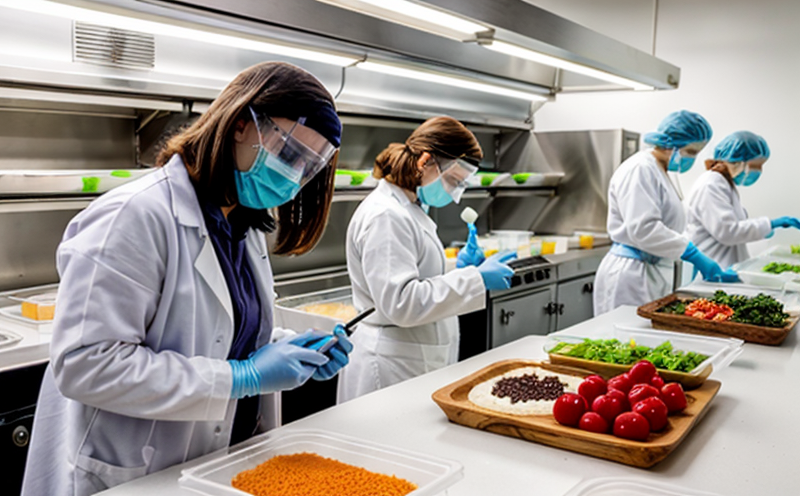ISO 16649-2 β-glucuronidase Positive E. coli Testing
The ISO 16649 series of standards provides internationally recognized guidelines for the detection and identification of microorganisms, including those that exhibit specific metabolic pathways such as β-glucuronidase activity. This testing method is particularly useful in food microbiology where it helps identify Escherichia coli strains capable of expressing this enzyme.
The significance of β-glucuronidase-positive E. coli lies in its potential to degrade environmental estrogens and other xenobiotics, which can have implications for both human health and the environment. This testing is essential for ensuring food safety by identifying pathogenic or potentially harmful bacteria that might not be detectable using standard methods.
The process involves a series of steps where samples are first prepared according to ISO 16649-2, then inoculated onto selective media containing chromogenic substrates that react with β-glucuronidase. Positive colonies exhibit distinct colors or pigments indicative of the presence of E. coli producing this enzyme.
Understanding the significance of these tests is crucial for quality managers and compliance officers in ensuring regulatory adherence and maintaining product integrity. For R&D engineers, this method can offer insights into microbial ecology and potential uses of these organisms. Procurement professionals might utilize this testing to evaluate suppliers' practices regarding food safety and hygiene.
By adhering to ISO standards, laboratories ensure consistency and reliability across different regions, which is vital for global trade and consumer trust. This methodology aligns with broader environmental sustainability goals by helping reduce the presence of harmful bacteria in food products, thereby lowering risks associated with contaminated food.
- Reduces contamination risk during food production
- Enhances traceability and transparency in supply chains
- Promotes safer consumption practices globally
- Supports regulatory compliance and consumer confidence
In conclusion, the ISO 16649-2 β-glucuronidase test is a critical tool for maintaining food safety standards. It allows laboratories to provide robust evidence of microbial quality assurance, contributing significantly to public health and environmental protection.
Scope and Methodology
The ISO 16649 series focuses on the detection and identification of microorganisms that express specific metabolic pathways. Specifically, β-glucuronidase-positive E. coli testing aims to identify strains capable of degrading certain substrates through this enzyme.
For food microbiology applications, this test is conducted using ISO 16649-2 compliant protocols. The process begins with the preparation of samples according to standard procedures, followed by inoculation onto selective media containing chromogenic substrates sensitive to β-glucuronidase activity. Colonies that exhibit color changes or other visual indicators are then identified as potential β-glucuronidase-positive E. coli.
The methodology ensures accuracy and reliability through standardized techniques and reagents. This approach is particularly beneficial for laboratories seeking consistent results across different batches and locations. The test also supports the broader goals of food safety by providing a means to monitor and control the presence of harmful bacteria in processed foods.
Environmental and Sustainability Contributions
The use of β-glucuronidase-positive E. coli testing contributes positively to environmental sustainability efforts by reducing contamination risks during food production processes. By identifying and eliminating potentially harmful strains, this testing helps ensure that only safe and uncontaminated products reach the market.
- Reduces waste generated from contaminated product recalls
- Promotes resource efficiency in agricultural practices
- Enhances biodiversity by minimizing the spread of invasive species
- Supports cleaner production technologies through improved hygiene standards
Through its role in maintaining high-quality food products, this testing supports broader sustainability goals. It helps reduce the environmental impact associated with contaminated foods and promotes safer consumption practices globally.
Competitive Advantage and Market Impact
Adopting ISO 16649-2 β-glucuronidase-positive E. coli testing provides significant competitive advantages for food manufacturers, distributors, and retailers. By ensuring adherence to stringent international standards, companies can demonstrate their commitment to quality and safety, thereby building trust with consumers.
This testing method enhances the reputation of organizations involved in the food industry, making them more attractive to investors and partners. It also facilitates smoother compliance with regulatory requirements, reducing the risk of costly penalties or recalls. For R&D teams, this method offers valuable insights into microbial behavior, potentially leading to innovations in processing techniques and product development.
Moreover, the use of this testing aligns companies with global sustainability initiatives, enhancing their brand image and market position. In an increasingly environmentally conscious world, consumers are more likely to choose brands that prioritize safety and sustainability.





